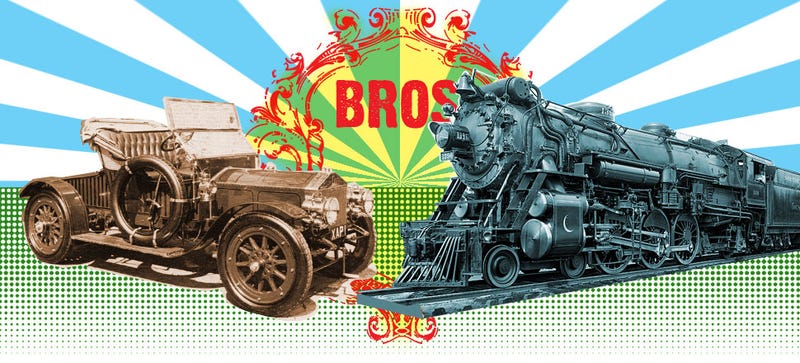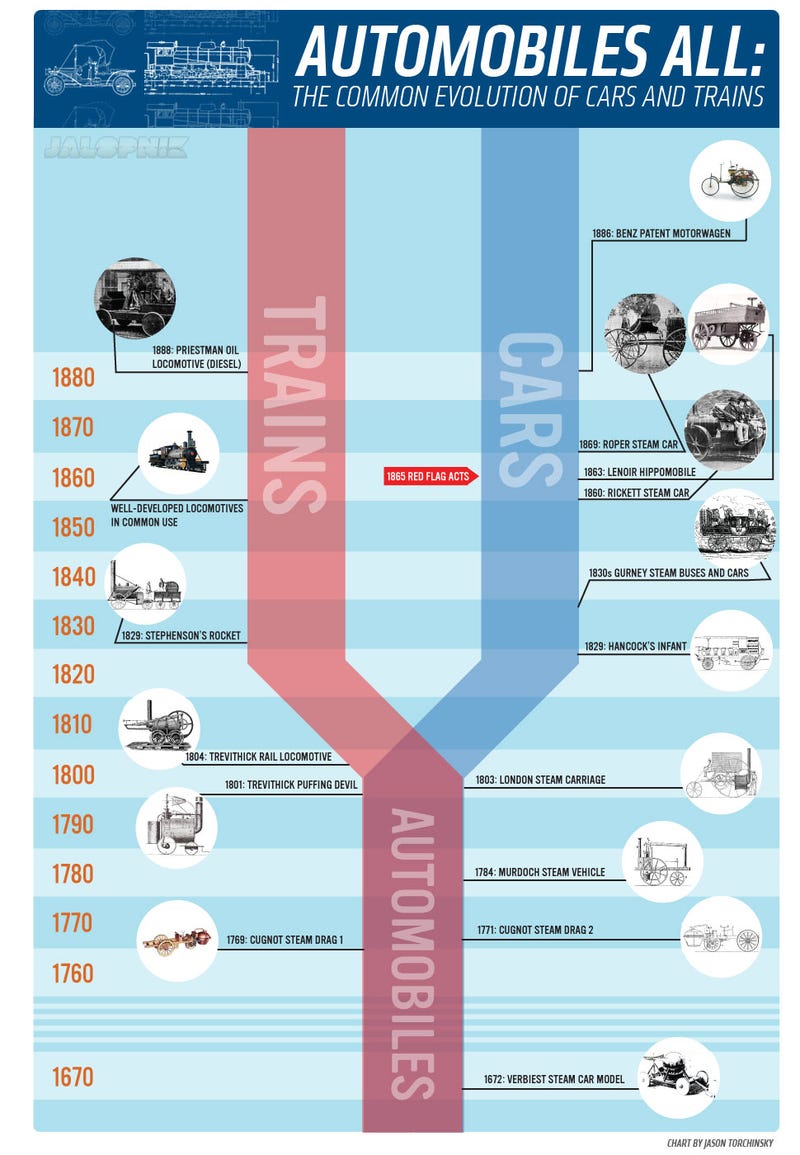
The story most people know about the origin of the car is wrong. The real story is, of course, much more complex and muddy, and is inexorably tied to the development of trains. Automobiles — self-propelled machines — really should refer to both trains and cars, and I think I know how the timeline should look.
The most common origin story for the car — the one most casual Googlers find — is pretty flawed. As the story is most commonly told, the automobile has two main origin points: Cugnot’s Steam Drag of 1769, and Benz’ Patent-Motorwagen of 1886. These two points, while important, don’t come close to the whole story.
In fact, there’s a solid century of automobile development that’s left out and barely mentioned in the historical narratives most people are likely to encounter. Part of this is because companies like Mercedes-Benz very much want the mantle of “inventor of the car,” regardless of how meaningless their claim actually is. And, believe me, it is meaningless.
Part of the issue is that we have always made a hard distinction between trains and cars, and I’m not really sure that should be the case. Railroad travel and motorcar travel both came from the same fundamental sources, and, fundamentally both are automobiles — self-propelled machines.
In the new timeline of the history of the automobile I’m proposing, there would be a clear emphasis on the common origin of cars and trains, and while there is a major (and fairly early) split in the two groups, the development of locomotives and rail travel should be looked at as two species of the same animal: the automobile.
I would start the automobile’s development with the work of Ferdinand Verbiest and his miniature steam car/toy created for the Chinese Emperor way back in 1672. Yes, this was just a model, but it appears to be the first vehicle of any kind that was capable of propelling itself via the consuming of some sort of fuel to power a motor.
The first human-drivable automobile I think would then be Cugnot’s 1769 Steam Drag. This nearly century-long gap I think actually is pretty devoid of real automobile development, unlike the next 100 years, which were jam-packed.
After Cugnot’s less-than stellar successes with his strangely designed FWD steam behemoths (there was another in 1771), we see Scotsman William Murdoch vastly improving and reworking the idea of a self-propelled steam vehicle, which he produced a working (subscale) model of in 1784.
In 1801, Richard Trevithick built a working “road locomotive” — a car — and called it the “Puffing Devil.” It ran, carrying passengers up Camborne Hill. There’s even a song about the event. The Puffing Devil was lost to carelessness soon after the ride, but he built another automobile in 1802, and a more advanced model called the London Steam Carriage in 1803. The London Steam Carriage is likely the first purpose-built motor vehicles designed specifically to transport people ever.
At this point, 1804, the initial split between railroad and road-going vehicles occurs, for several reasons. The most obvious one is that with rails, you no longer have to worry about the conditions of the road, because you know exactly what sort of surface you’ll be running on. Also, since steering is handled by the track itself, no complex steering mechanisms need to be developed. Automobiles took to the rails because, frankly, it was easier.
Once the guesswork or road surface and freedom from having to steer happened, the automobile became free to be scaled up dramatically. Because the laying of railroads was such a costly proposition, the only way to make it economically viable would be to carry as many passengers and goods as possible, hence the evolution of trains into such colossal beasts.
You can think of locomotives as the dinosaur branch of the automobile evolution — environmental conditions selected massive size over maneuverability or private ownership, and the result was the whole category of trains.
Development of road cars continued in parallel to trains. By the 1830s, pioneers like Goldsworthy Gurney were building road-going automobiles and operating omnibus services between various English cities. These were popular enough that people were already speculating and complaining about motor vehicle traffic. In the 1830s!
Road-going steam automobiles would have likely continued to develop rapidly in Britian were it not for the extremely oppressive Red Flag Acts (or Locomotive Acts), started in 1861, which imposed extremely severe restrictions on road-going automobiles. The acts may have been clandestinely funded and supported by the horse-carriage and railroad industries, and these acts served to severely stifle road automobile development in the UK until their repeal in 1896.
The slowing down of the road automobile business did help the railroads to grow and develop, though road automobile development was still happening outside of the UK — though some interesting things were still happening in the UK, like the first car ever to be sold to a private buyer, in 1861.
In France, Belgian inventor Etienné Lenoir had an internal-combustion vehicle called the Hippomobile, way back in 1863. By the 1870s Amedée Bollee was building steam cars with front engine/rear drive layouts and independent suspension in limited but series production.
In 1875, Austrian Sigfried Marcus built the first working internal combustion gasoline engine, a good eleven or so years before Karl Benz’ motorwagen. Of course, soon after, we do get to the Benz Motorwagen, and that, with its Otto-cycle engine, was one of the pioneers of modern automobiles.
The big take-away here, though, is that automobiles have been in continuous commercial use and development since at least the early 1800s, though much of that activity in the 1800s was in the branch of automobiles that requires tracks to run. But that really doesn’t make them automobiles any less.
Cars and trains are both self-propelled vehicles, both automobiles. They both came from the same initial experiments and research and vehicles. The artificial division by which we treat the origin of the two machines is counter-productive, and I’d like to see it stop.
When we talk about the origin of the car, we can no longer mention that crazy French machine and then leapfrog to the Benz Motorwagen, no matter how much Mercedes loves that. There’s a whole century of largely ignored automobile development — and that includes railroad locomotives — that deserves attention, and I want to see that happen.
To that end, here’s a chart of my proposed new timeline of automotive development. Help me spread the word. Thanks!

Sent from my Tricorder
